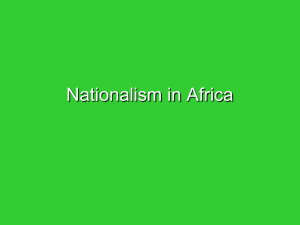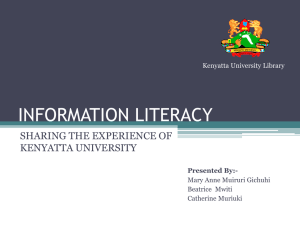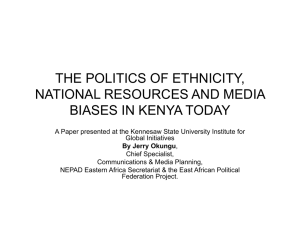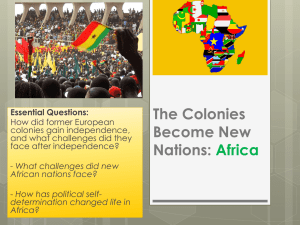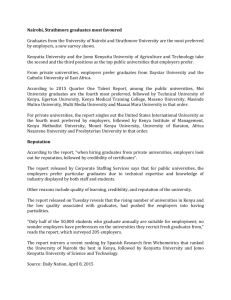Kenyatta University, Kenya - Association of African Universities
advertisement
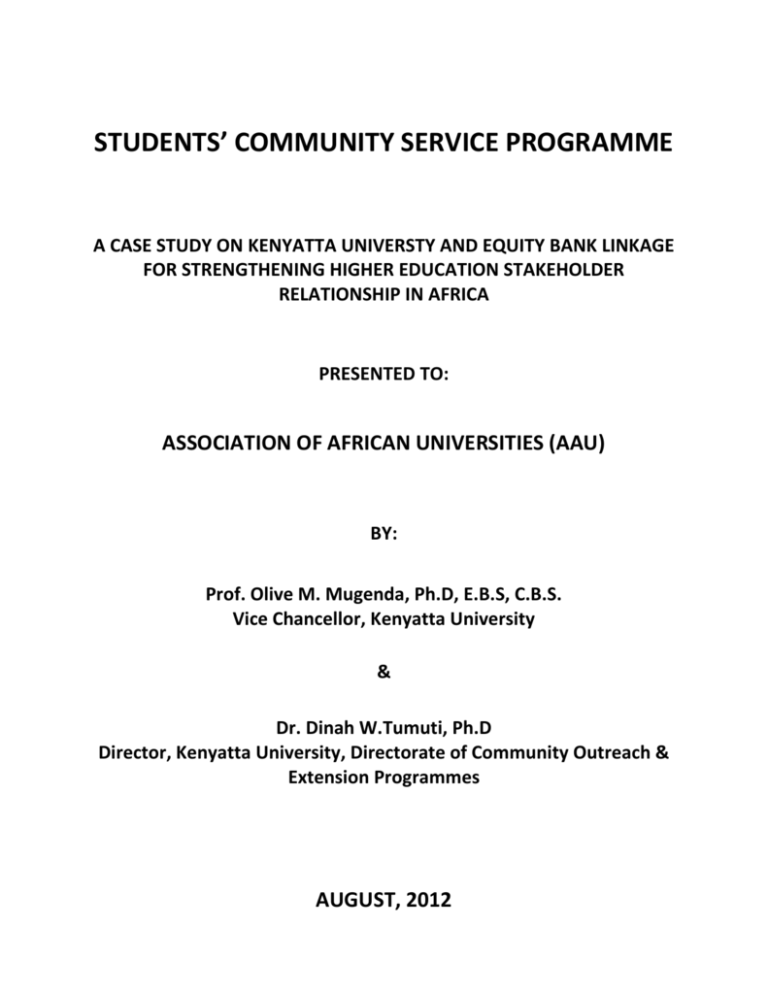
STUDENTS’ COMMUNITY SERVICE PROGRAMME A CASE STUDY ON KENYATTA UNIVERSTY AND EQUITY BANK LINKAGE FOR STRENGTHENING HIGHER EDUCATION STAKEHOLDER RELATIONSHIP IN AFRICA PRESENTED TO: ASSOCIATION OF AFRICAN UNIVERSITIES (AAU) BY: Prof. Olive M. Mugenda, Ph.D, E.B.S, C.B.S. Vice Chancellor, Kenyatta University & Dr. Dinah W.Tumuti, Ph.D Director, Kenyatta University, Directorate of Community Outreach & Extension Programmes AUGUST, 2012 TABLE OF CONTENTS A. INTRODUCTION AND BACKGROUND INFORMATION ........................................................................... 3 National Aspects of Industry and Productive Sector in Kenya ................................................................. 3 Profile and Brief History of Kenyatta University ....................................................................................... 5 University – Industry Linkages at Kenyatta University ............................................................................. 6 Promotion and Management of Linkages at Kenyatta University ............................................................ 7 The Current University – Linkages at Kenyatta University and their Stakeholders .................................. 7 1.1.1 Role of National Media Group (NMG) .................................................................................. 9 1.1.2 Role of Kenyatta University................................................................................................. 10 B. STUDENTS’ COMMUNITY SERVICE PROGRAMME: UNDER THE LINKAGE OF KENYATTA UNIVERSITY AND EQUITY BANK ...................................................................................................................................... 14 Development & Planning ........................................................................................................................ 14 Overall Goal of the Linkage ..................................................................................................................... 14 Implementation & Management ............................................................................................................ 15 Funding of the Programme ..................................................................................................................... 17 Challenges and Constraints..................................................................................................................... 18 Outcome / Output of Students’ Community Service Programme .......................................................... 20 Planned Future Outcome/Output........................................................................................................... 22 Sustainability ........................................................................................................................................... 22 Relevance of Students’ Community Service Programme at the Institutional, National and Continental Levels....................................................................................................................................................... 23 C. CONCLUSIONS AND RECOMMENDATIONS ......................................................................................... 25 Conclusions ............................................................................................................................................. 25 Recommendations .................................................................................................................................. 26 2 A. INTRODUCTION AND BACKGROUND INFORMATION National Aspects of Industry and Productive Sector in Kenya The Republic of Kenya, whose capital city is Nairobi, is located in East Africa and lies astride the equator with a land area of 580,000 km2 and a population of slightly over 43 million residents. The independent Republic of Kenya was founded in December 1963. Following a referendum in August 2010, a new constitution was adopted that has replaced the older one inherited from the British Imperial Government at independence. Currently, Kenya is divided into 47 semiautonomous counties that will be governed by elected governors by December, 2012 and whose governance structures will operate independent of the central government in Nairobi which is a regional commercial hub. The economy of Kenya is the largest by GDP in East and Central Africa, and agriculture still remains the major employer. Kenya has remained a traditional exporter of tea and coffee, and more recently fresh flowers to Europe. The service industry is a major economic driver. In joining many developing countries as they embrace industrialization as a means of achieving structural transformation of their economies, Kenya has embarked on a strategy that focuseds on economic development and eradication of principal challenges of employment creation and poverty. The Government began by building on a 1996 development policy framework that aimed at guiding achievement of industrialization by the year 2020 (KIPPRA, 2000). By the turn of the 21st century the industrialisation policy framework which foregrounded industry as the leading sector for addressing the development challenges of the country proposed to provide “selected” industries at various stages in the industrialization process, with the aim of supporting them and enabling them to grow and become exporters of their products. This notwithstanding, an apparent failure emerged in this policy strategy that was lined to absence of a holistic approach that would monitor and address constraints, conflicts and trade-offs that faced producers in all sectors of the economy (KIPPRA, 2000). In order to address potential industrialisation failures, the Kenya Government embarked on a more comprehensive policy strategy dubbed the Economic Recovery Strategy for Wealth and 3 Employment Creation (2003 – 2007). The successful implementation of this strategy enabled the country’s economy to grow from 0.5% (2002) to 6.1% in 2006 and to 7% in 2007. This success was followed by a broader and even more elaborate national plan on industrialisation, named the Kenya Vision 2030 (GoK, 2008). The Kenya Vision 2030 is designed to provide the necessary industrialisation continuity that is built on the successes of the Economic Recovery Strategy of 2003-2007. The Kenya Government fronted this approach as key to ensuring that the nation entered and remained in a mode of industrialisation that would propel Kenya into a newly industrialized middle income country by 2030 to enhance the “quality of life for its people in a safe and secure environment”. Improvement of the quality of life for all citizens was later to be enshrined in the recently promulgated Kenyan Constitution (GoK, 2010). Based on this foresight, the Kenya Government created the Ministry of Industrialization and charged it with the responsibility of managing and steering the manufacturing sector towards the realization of the industrialisation vision as articulated in the nation’s strategic plan for Year 2030. In turn, the Ministry of Industrialisation has developed a 5-year strategic planning (20112015) aimed at ensuring systematic attainment of Kenya’s industrialisation vision. In the plan, the national industrialization process in Kenya was designed to revitalise and build on previous efforts that the government had made in crafting policy interventions that are capable of propelling the country towards industrial growth and development and in the long run help attain an average growth rate of 10 per cent per annum. Contextually, the Kenya Government, through the Ministry of Industrialisation, is emphasizing on encouragement of selective industries to produce for export and by the process increase their employment potential (RoK, Ministry of Industrialisation, 2011-2015). This strategy, distinguishes itself from past initiatives in two ways. First, industry is for the first time defined as the leading sector in economic development, and second specific industries are for the first time earmarked for government support. The strategy is also designed to be implemented over a two-stage period. In the first phase, the government will focus on assisting labour-intensive, resource-based and light manufacturing industries. In the second phase, policy will target intermediate and capital goods industries that are more technology and capital intensive but 4 which are constrained by infrastructure, technology, human capital and savings. These industries, which include metallurgical, non-petroleum-based chemical, petro-chemical, pharmaceutical, machinery and capital goods industries are expected to produce initially for the domestic market and eventually for the export market. The ultimate aim of this strategy is to yield a diversified and dynamic industrial base by the year 2020 and beyond with a GDP per capita almost five times of those witnessed in the previous century. Profile and Brief History of Kenyatta University The history of Kenyatta University dates back to 1965 when the British Government handed over Templer Barracks to the Kenya Government which, in turn, established a national educational institution whose mandate was to train secondary school teachers for expansion of education system of the new post-colonial Republic of Kenya. The education institution was named Kenyatta College in honour of the founding president of the nation, Mzee Jomo Kenyatta. Initially, Kenyatta College was divided into two sections, the Secondary Education Division (SED) and the Teacher Education Division (TED). The Secondary Education Division had classes from Form I to Form VI. Forms I and IV and the Advanced level Arts classes were phased out in 1969 to give way to seven Advanced level Science classes which earned the institution high reputation for its excellent performance in the Advanced level examinations. The Secondary Education Division was phased out in 1973 following the establishment of Kenyatta University College by an Act of Parliament of 1970. Kenyatta University College (KUC) became a constituent College of the University of Nairobi. In 1973, Kenyatta University College (KUC) admitted its first batch of 200 students to pursue studies leading to the award of the Bachelor of Education degree of the University of Nairobi. By 1978 the number had increased to 7,000. Over the years, the University College continued to distinguish itself as a leading teacher training institution, nationally and in the East African Region. A growing quest to become a university resulted in the phasing out of SI and SA, Teachers’ Certificate courses by 1975 which gave way to the Bachelor of Education (Science), Bachelor of Education (Arts) degree programs and a two-year undergraduate Program of Diploma in Education. In July 1978, the Government transferred the entire Faculty of Education of the University of Nairobi to Kenyatta University 5 College Campus. As a result, the College became the only institution in the country training teachers at both undergraduate and postgraduate levels. On August 23rd, 1985, Kenyatta University became a full-fledged University when it received Presidential assent to assume an independent university status. The Act became operational on September 1, 1985 and the new University was inaugurated on December 17, 1985. Kenyatta University immediately started establishing new Faculties and constituent colleges, beginning with Jomo Kenyatta College of Agriculture and Technology (JKCAT) as its constituent College in 1988 until it attained its autonomy later as full – fledged university. The new Kenyatta University housed the African Virtual University (AVU) which was originally conceptualized as a technology-based distance education network to bridge the digital divide in Africa, especially by building capabilities in science and engineering. The participation of Kenyatta University in the AVU was seen as an opportunity that revitalized and supplemented existing academic provision in the campus. In 2004/2005, Kenyatta University developed a comprehensive Strategic and Vision Plan (2005-2015) which has been the foundation of its current tremendous growth, in terms of both infrastructural development and student population which currently stands at approximately 44,000, with 48% of them female. In addition, the University has grown from the traditional academic faculties of Education, Arts and Sciences to a total of 14 academic schools, including a Graduate School. The School of Education has remained the largest with over 20,000 students thus reflecting the University’s historical niche in this area. Others include The Schools of Humanities, Social Sciences, Pure & Applied Sciences, Business, Economics, Applied Human Sciences, Hospitality & Tourism, School of Public Health Sciences, Law, Medicine, School of Visual and Performing Arts and Engineering. University – Industry Linkages at Kenyatta University Linkages at Kenyatta University are as old as the university which started in 1985. The linkages have been with international universities in various countries, government organizations such as the British Council, the German organization, DAAD,. Non-governmental organizations such as the Rockefellar Foundation and Ford Foundation. However a formal office for linkages was 6 The Current University – Linkages at Kenyatta University and their Stakeholders established in 1996. It is currently called “The Center for Linkages and International Collaboration” (CLIC), which is headed by a Director and advised by a Linkages Board whose chairman is the Vice Chancellor. The objectives of the linkages are to support capacity development, research, promote cultural understanding, student exchanges and other areas of mutual interest. The university is very active with over 100 formal linkages with various organizations in many countries. In 2006, the mandate of the Center was expanded to include industry linkages. In order to strengthen university industry linkages, industry linkages was removed from CLIC in 2010 and a new directorate formed – The University Industry Partnerships. Other centers having links with industry at the university include the (a) Center for Career Development & Attachment Programs, (b) Center for Entrepreneurship and Enterprise Development and (c) Community Outreach & Extension Program. Linkages with industry are highlighted as a key priority area in the revised Kenyatta University Strategic and Vision Plan 2005-2015. This is discussed in Chapter five of the strategic plan. Kenyatta University endeavours to be a center of excellence for research, generation of knowledge and development in new technologies. To intensify innovation the university will continue to encourage collaboration with industry. Two of the flagship projects in this priority area include (i) the establishment and equipping of a Business innovation and incubation center and (ii) an industrial and science park. Promotion and Management of Linkages at Kenyatta University The Directorate of University Industry Partnerships coordinates the industry links. The Directorate is headed by a director and has two administrative and support staff .Three approaches to initiating linkages are used .(i)The directorate initiates new links according to its strategic plan; (ii) Academic department initiates links relevant to the curriculum (iii) Industries initiate the collaboration with the University for mutual benefit. All the linkages are formalized by the Directorate. 7 Organization 1. Chandaria Foundation Objective a) To jointly support outstanding innovative and entrepreneurial ideas from Kenyatta University students and other Kenyans for incubation. b) To seek funding to support incubatees. c) To encourage patenting of innovative ideas. d) To apply the provisions of Centre’s Strategic Plans or organizational targets to ensure the best outputs are achieved through the MoA. 2. Telkom (K) Orange a) Providing Wi-Fi hotspots at the Kenyatta University innovation hub b) Providing preferential calling rates on Orange Mobile to students and staff within the University environs c) Use of each other’s equipment and facilities subject to adequate prior notice and availability, d) Participation in jointly organized seminars, workshops and conferences including participation with other collaborators in areas related to telecommunication and other university activities 3. Youth Enterprise a) Joint youth empowerment and training programs Development Fund b) Organization and hosting of joint short term training courses c) Joint institutional capacity building d) Exchange of staff and students e) Sharing of equipment and facilities f) Joint tendering of consultancy and technical assistance g) Dissemination of research findings through seminars, workshops, conferences and publications in peer refereed 8 journals h) Exchange of information and documentation i) Collaboration funds raising for joint projects 4. Nation Media Group 1.1.1 Role of National Media Group (NMG) NMG shall be responsible for delivery of the benefits of the Agreement KU pursuant to this Agreement which shall include: (a) Identification of KU as the knowledge partner in all advertisements and communications relating to the Project whether on NMG’s media outlets or otherwise; (b) Provide media visibility to KU in relation to the Project events including but not limited to: (i) A call to action advertising and editorial campaign across the print and electronic media outlets of NMG; (ii) The publication of posters, fliers and other activations in relation to the project and its events with due credits to KU as the knowledge partner; (iii) Production of a Television feature for broadcast on the day of award of the prizes for the winners of the project competition; (iv) Publication of a Magazine feature of the project and its events on the Newspaper after the final event of the project with due recognition to KU’s role as knowledge partner for the Project; (c) Provide KU’s personnel with direct access to the finalists of the Project for the purposes of development of case 9 studies; (d) Subject to its discretion to Jointly with KU, seek sponsorship to mentor the 20 top finalists for 12 months 1.1.2 Role of Kenyatta University KU on its part shall perform the following functions and bear the following responsibilities in relation to the Project: (a) Develop the criteria and matrices to be used in the selection of the best ideas by the Competitors; (b) Provide personnel to be part of the panel that will scrutinize the entries by the Competitors to determine the best entries; (c) Provide training and guidance to the top 20 finalists prior to the final presentation of their business ideas (d) Generally act as the knowledge advisor to the Project. (e) Provide the payments that may be required by the KU personnel involved in the project. (f) Jointly with NMG subject to NMG’s discretion, seek sponsorship to mentor the 20 top finalists for 12 months. 5. Mahanaim Education (a) KU: Institute (MEI) KU shall implement the agreed activities and ensure that the following obligations are fulfilled: (i) Provide professional music training courses, curriculum and external examiners to MEI as per KU regulations (ii) Provide required infrastructure and resources required for joint music training 10 (iii) Provide the required physical and resources and music facilities. (b) Mahanaim Education Institute (MEI): MEI shall implement the agreed activities and ensure that the following obligations are fulfilled: a) Participate in the implementation of the approved joint music training b) Provide exposure in music to KU students and staff c) Provide necessary information for musical project(s) based on agreed terms and conditions d) Provide expertise in music training as well as short training courses. e) To create joint projects that can provide more access to music facilities available at MEI f) Establish joint academic programs 6. University of Western a) Exchange of faculty members; Ontario b) Exchange of students; c) Joint research activities; d) Participation in international seminars and academic meetings; e) Exchange of academic materials and other information; f) Special short-term academic programmes. 7. Kenya Wildlife Service a) Scientific research, bio-prospecting and research for development b) Field/Industrial attachment c) Organization of seminars and workshops d) Professional and academic training e) Consultancies 11 f) Documentary dissemination g) Library use and information exchange h) Institution of corporate membership i) Team building and sports programmes j) Life saving and safety education k) Camping and outdoor leadership education l) Environmental conservation, biodiversity and tourism development m) Guest lectureship n) Marketing through cultural values, arts, fashion and design, sports and tourism o) Publicizing issues on conservation, training courses and research p) Environmental Impact Assessment and Audits, monitoring and evaluation q) Environmental education r) Corporate responsibility and affirmative action s) Field studies and excursions t) Training of trainers 8. National Council for a) To individually or jointly identify & outstanding innovative Science Technology and and entrepreneurial ideas from all Kenyans for incubation. b) To jointly or individually seek funding to support incubates. c) Kenyatta University’s Business Innovation & Incubation Centre as well as at other centers in the country that may be found to require the joint assistance of the two organizations. d) To conduct joint research and produce publications and patents as shall mutually be deemed necessary under this MoA. 12 e) To apply provisions of their own strategic plans to ensure the best outputs are achieved through this MoA. 9. Equity Bank for a) To enable the University realize its core value of service to Students’ Community Service Programme humanity. b) To help communities identify, mobilize and utilize their resources to improve quality of life. c) To offer experience to the students through their interaction with communities. d) To give Kenyatta University students an opportunity to give back to their communities under whom they serve. e) To help the collaborating institutions improve Kenyans quality of life through spirit of cooperate social responsibility. 13 B. STUDENTS’ COMMUNITY SERVICE PROGRAMME: UNDER THE LINKAGE OF KENYATTA UNIVERSITY AND EQUITY BANK Development & Planning Students’ Community Service Programme (SCSP) is a brainchild of Prof. Olive Mugenda, Vice Chancellor, Kenyatta University. After conceiving the idea of service to humanity through students, she shared it with other members of University Management who supported the programme. The programme was introduced to the Directorate of Community Outreach and Extension Programmes which was just established in July, 2007. With the guidance and support of Prof. Olive Mugenda, the linkage proposal to Equity Bank on this programme was developed and shared among the two institutions. The programme representatives of the two institutions held several consultative meetings after which the programme proposal was agreed upon by both Kenyatta University and Equity Bank. To formalise the linkage, a Memorandum of Understanding (MoU) was developed and signed between the Vice Chancellor, Kenyatta University, Prof. Olive Mugenda and Chief Executive Officer and Managing Director, Equity Bank, Dr. James Mwangi on 11th June, 2008. The agreed duration of the linkage is five years which is renewable. The programme has since then been housed in the Directorate of Community Outreach and Extension Programmes which has been implementing it for the last four years. The first group of 3,000 Kenyatta University students went to the field in July/August vacation 2009. The programme is now on its third year of operation. Overall Goal of the Linkage The overall goal of the linkage is to expose Kenyatta University students to the Society’s way of life and enable them serve communities in real life situation as they also learn from their interaction with the communities they serve. Further, the linkage aims at removing “ivory tower” mentality held by the society about institutions of higher learning and financial institutions which will help the stakeholders interact freely and complement each other in improving quality of life among Kenyans. The above goal is accomplished through the following specific objectives:14 a) Exposing students to the socio-cultural, economic and spiritual life of their communities where they will live and work after completing their education. b) Providing students with an opportunity to identify with the problems and needs of their communities. c) Offering students an opportunity to acquire and apply life skills that would enable them deal with community’s issues and problems. d) Enabling students develop cooperative attitudes and team spirit. e) Exposing students to the actual community developmental issues involving production, distribution and consumption of goods and services. f) Exposing students to the available human and material resources that facilitate production, distribution and consumption of goods and services. g) Exposing students to networking process and information sharing among themselves and the wider society. h) Enabling students realize their creativity and innovativeness in making contributions towards addressing the needs of their communities. i) Enabling communities interact freely with the other stakeholders in this programme as they seek to improve their quality of life. j) Enabling Equity Bank reach out to communities, who are their clients and help them improve their standard of living by extending their products and services to them. k) Enabling the two linking institutions improve the lives of Kenyans through the spirit of cooperate social responsibility. Implementation & Management The Programme is managed by the Director, Community Outreach and Extension Programmes in a well established office assisted with nine (9) Advisory Board members appointed by the Vice-Chancellor from among University Professors and Lecturers from different disciplines in the university. The Directorate has also established network with representatives from all the academic departments whose main role is to link students from their respective departments with the Directorate of Community Service and Extension Programmes and participate in field 15 in field community-based projects where applicable. Through facilitation of both partnering institutions, about 3,000 Kenyatta University students both male and female participate in the programme annually during the University vacations. To avoid geographical bias, students are selected on the basis of geographical areas they come from. When in the field, students undertake their projects through organizations/institutions such as hospitals, children homes, homes of the aged, schools, rehabilitation centers, churches, chief’s camps and anywhere else where their services are needed. In the process of doing their projects, students are attached to the field host supervisors who assign them duties, give them guidance and supervise them. After their community service period is over, the host supervisors fill their evaluation forms and send them back to the Directorate of Community Outreach and Extension Programmes in a sealed envelope. To prepare students for Community Service, both Kenyatta University and Equity Bank train them on contemporary issues they are likely to encounter in the field during their field projects. The topics covered in the training seminar include the following: HIV/AIDS awareness Drugs and Substance abuse awareness Food and nutritional security Tree planting, environmental conservation and management Peace building and conflict resolution Gender mainstreaming Motivational talks in schools and student empowerment Basic financial skills and entrepreneurship Sports and games Communication and extension skills Volunteerism Contemporary issues in the community continue to be identified through students’ field reports and added to the list of the training programme accordingly. The Directorate is in the process of 16 developing a Training Manual which will include the above topics and any other which will be found necessary to enhance student’s capacity and hence the quality of the Programme. After training and initiating the students to the Programme, they are issued with field materials to help them in the process of their field project as follows: Operation manual A T-Shirt bearing the names and logos of both Kenyatta University and Equity Bank Materials developed by Equity Bank on their products and services which are relevant to the community Facilitation allowance enough for lunches and local transport Structured field experience report form Evaluation form to be filled by the host supervisor Students are encouraged to undertake community service in their home area or anywhere else where they can secure accommodation since the facilitation allowance does not include accommodation. Funding of the Programme Students’ Community Service Programme is funded jointly by Equity Bank and Kenyatta University. Equity Bank contributes both financially and in training students in financial management skills and entrepreneurship. Further, the bank involves the students in various field activities during the time they are in the field including tree planting and field seminars where applicable. Most of Kenyatta University contribution is in kind due to availability of trained man-power and expertise from a wide range of professional discipline. Occasionally, the programme representatives from Kenyatta University and Equity Bank come together to discuss modalities of reaching out to communities more efficiently and to discuss other ways of reaching out to the community with needed skills. For example, for the short time the two institutions have been in collaboration, a Financial Education Mentorship and Training Programme for Kenyan youth has been undertaken to intensively train Kenyan youth on financial management skills. The programme has already trained 5,249 community youth 17 countrywide and 2,842 Kenyatta University students in five thematic areas including budgeting, banking, saving, borrowing and debt management. The skills gained from this project have greatly improved financial attitude and practice among Kenyatta University students as was found from an impact assessment report by the Directorate of Community Outreach and Extension Programmes at Kenyatta University. As indicated by the students in the report, they are able to concentrate better in their studies when they don’t have financial anxiety. Students’ Community Service Programme is voluntary in nature where the two collaborating institutions work together under the spirit of cooperate social responsibility to help Kenyan communities improve the quality of life. The linkage does not generate income. However, through this programme, the linkage has directly and indirectly helped individuals, families and communities to improve their financial status besides imparting on other areas of their lives. Challenges and Constraints A number of challenges and constraints have been encountered during the implementation of this Programme and based on impact assessment contacted on the students who had undertaken the programme and their supervisors by the Directorate of Community Outreach and Extension Programmes in 2011, some challenges/constraints are listed below:SNO Challenges/ Constrains SNO Overcoming the Challenge 1 Change of the semester dates 1 The Directorate has been able to adjust has been one of the major its programme based on the change of challenges since students go for semester dates by the University which community service when they is communicated on time. are on their University holidays. When semester dates change, students are either not trained on time or go for community service as planned earlier. 2 Delay of financial support from 2 18 The Directorate changes the training to Equity Bank. When there is a delay of financial when the finances are available. support, students are not trained on time and therefore cannot participate on the programme as scheduled. 3 Shortage of funds. There are 3 Just take enough students who can be more University facilitated by the available finances and students who are interested in encourage the other students to participating on the SCSP but undertake community service during the available funds are not the weekends and National holidays enough for all of them which when classes are not being offered. Kenyatta makes selection student’s of the participants very difficult. 4 Training duration. Two days are 4 not enough for training student adequately on all Priotize the training topics. The Directorate is working on the improving the current model to contemporary issues identified increase the number of training in the communities. days. The Directorate is planning to develop a training manual which students can refer to during the training period and when they are in their field projects. 5 The project period of two 5 The weeks is not long enough for improving students increasing the duration of the field to undertake the 19 Directorate which is working will on consider project adequately. Students projects by the students. need atleast one month. 6 Supervision. Considering the 6 evaluation report. students are going all over the country, the few available Contact others field supervisors and students through the phone. University supervisors cannot supervise every student who is Rely more on host supervisor’s The University supervisors undertaking the project in the sample students in all the eight community. provinces in Kenya to have a general picture of the field situation. 7 Insecurity and diverse weather 7 Contact the students and their condition. Some areas are not supervisors through their telephone accessible due to insecurity and numbers where the University bad weather conditions even supervisors cannot access the areas. though students undertake the project there because it is their home area. Outcome / Output of Students’ Community Service Programme To determine the benefits of the linkage to the stakeholders, that is, students, the served communities and the two collaborating institutions (Kenyatta University and Equity Bank), the Directorate of Community Outreach and Extension Programmes did impact assessment study between September and November, 2011. Using students who had undertaken community service, the served communities and the two collaborating institutions. The impact assessment was done against the objectives which were earlier set to guide this programme and most objectives were achieved according to the University’s expectations. The outcomes/outputs of this linkage are highlighted here below. 20 i). Students attained knowledge and skills on contemporary issues from the training seminar they undertake before they go for community service projects which they use to better their lives. ii). Students learn the real life situations in the community through their interactions with the communities they serve. iii). Students develop strong ties with the communities they serve and are able to develop inter person relationship which removes fear and anxiety between them. iv). Students are able to identify with problems of their communities and are able to use their skills and creativity to address them in collaboration with the communities. v). Students were able to create awareness to the communities they serve about contemporary issues in the society such as HIV/AIDS, drugs and substance use, environmental issues, peace and conflict resolution, food and nutritional insecurity among others and further empowered the communities to address them. vi). The linkage has helped many students to open bank accounts and to manage their finances better. vii). Some students have been able to network with various people, organizations/institutions in the community where some of them have been able to acquire jobs after they complete their education. viii). The linkage has helped the students to reach out to the communities and helped them to plant trees, mentor and give motivational talks to primary and secondary school pupils in a mature and responsible manner and at the same time cultivate the spirit of volunteerism. ix). Students have been able to exercise their creativity and develop self confidence as they help communities identify and utilize resources available to them to improve the standard of living in the community. x). The linkage has given the two collaborating institutions an opportunity to improve Kenyans’ quality of life in the spirit of cooperate social responsibility. xi). The linkage has removed the “Ivory Tower” mentality held by communities about institutions of higher learning and financial institutions. 21 xii). The linkage has helped Equity Bank to reach out to communities who are their potential clients and help to improve their quality of life as they market their products and services. xiii). Other community related Programmes have emerged from Students’ Community Service for example Financial Education Mentorship and Training Programme for the Kenyan youth which has helped both community and Kenyatta University youth to be better managers of their finances. Planned Future Outcome/Output In future, the Directorate is planning to do the following: Revise and improve the current Students’ Community Service Programme model to be able to accommodate all the University students in the programme. To introduce community service components to academic programmes to more sensitize Kenyatta University community on the importance of community service. To introduce Service Learning (SL) model where students will be given academic credit instead of certificate of participation. Develop a training manual on contemporary issues in the community which will be revised and updated accordingly as more issues emerge in the community. Incorporate Research Uptake Model where the University will be able to have intervention programmes in the community based on the research undertaken by both the students and academic members of staff. Sustainability The linkage operates under a five years’ renewable contract between Kenyatta University and Equity Bank guided by a Memorandum of Understanding (MoU) which was signed by the two Chief Executive Officers from the two collaborating institutions on 11 th June, 2008. As of now, the linkage is financially stable so long as the two institutions operate according to the agreement made between them and as long as viable Outcomes/Outputs are realized which the University through the Directorate of Community Outreach and Extension Programmes is 22 working hard to maintain under the guidance and the support of the Vice-Chancellor, Prof. Olive Mugenda. However, the Directorate of Community Outreach and Extension Programmes is in the process of intensifying the programme by developing other fundable programmes which will benefit and use the services of the students who are our main source of manpower. Relevance of Students’ Community Service Programme at the Institutional, National and Continental Levels The linkage has been very beneficial to the University teaching in that some academic departments have already started seeking how they can incorporate components of community service and volunteerism as they revise their training programmes. At the same time, students have already started seeing the relevance of their academic programmes to community service and volunteerism. As a result, students through their clubs/organizations have continued giving community service throughout the country while on session during weekends and public holidays which is facilitated by Kenyatta University through the Directorate of Community Service and Extension Programmes and supervised by their clubs/organizations patrons. The Directorate of Community Outreach and Extension Programmes has already established research issues some of which are complete while others are in progress. The research areas are mainly on contemporary issues in the society where the University is trying to develop capacity to improve the quality of life among communities through research uptake and utilization. The Programme on Development of Research Uptake in Sub-Sahara Africa is already taking routes in Kenyatta University through the Institute for Research, Science & Technology and the Directorate of Community Outreach and Extension Programmes is involved in the Programme on Research Uptake and Utilization especially for those which are communitybased. Community service at Kenyatta University has been participatory in nature. That is, instead of working for the community, the University has been engaging the community in identifying 23 their problems and the available resources which they together utilize to improve the quality of life among the Kenyan communities. By so doing, communities have established a working relationship with Kenyatta University where some members of the community freely come to seek for assistance from the University through the Directorate of Community Outreach and Extension Programmes. The linkage has benefited Equity Bank in that it has given it an opportunity to fulfill its mission of serving to Kenyans through a corporate social responsibility. Through the linkage, the bank has been able to reach many Kenyans from all over the country with its services and products. The bank has also had an opportunity to serve the University students by giving them an opportunity to reach out and give services to communities. Most of Kenyatta University students have been able to acquire laptops at a reasonable price through the goodwill of Equity Bank and hence improve their academic performance. The linkage has opened some other opportunities for Equity Bank to serve the community especially through Financial Education Mentorship and Training Programme for the Kenyan youth which has already trained a total of 8,091 youth both in the University and in the community. According to an impact assessment study done in the Directorate of Community Outreach and Extension Programmes in 2012, the Programme has drastically changed financial practice and attitude among Kenyatta University students who went through the programme. Volunteerism on Students’ Community Service Programme under University – Industry Linkage is a very important initiative both in developed and developing countries because it gives the stakeholders an opportunity to work together for the benefit of all. Particularly, the programme is important to students who are in the process of discovering their place in the society. It also gives the society an opportunity to embrace the young people and incorporate them in addressing the national issues. 24 C. CONCLUSIONS AND RECOMMENDATIONS Conclusions Students’ Community Service Programme, the University – Industry Linkage under the current case study has been in existence since June, 2008 when the Vice – Chancellor Kenyatta University and Chief Executive Equity Bank signed the MoU. The Programme has since then been implemented under the guidelines of the University Strategic and Vision Plan which emphasize service to humanity. Besides being a financial institution, one of the core values of Equity Bank is reaching out to Kenyan community to raise their standard of living by extending their products and services to them. Due to the common interest on society’s welfare of the two institutions, it has made it possible and easy for the two linking institutions to serve the Kenyan community together in the spirit of corporate social responsibility. The two institutions have jointly funded the Programme to facilitate Kenyatta University students to give service to Kenyans through institutions/organizations such hospitals, schools, children homes, homes of the aged, rehabilitation centers, government and nongovernmental organizations where service to community is required. The management of this linkage programme is managed on daily basis through a well established Directorate of Community Outreach and Extension Programmes which was initiated by Kenyatta University management in July, 2007. The Directorate is headed by a Director who is directly answerable to the Vice-Chancellor, two (2) Administrators, an Advisory Board of nine (2) members of staff appointed by the Vice-Chancellor together with the secretarial staff. Further, departmental representatives from each academic departments help to link students to the directorate and also in field supervision when students take their community service projects. When in the field, each student is attached to a supervisor from the host institutions where they do community service whose role is to guide, supervise and finally evaluate student’s performance after the project period is over. Together, the stakeholders mentioned above are able to deal with constraints and any challenges of the programme. So far no major problems have been experienced under this programme. 25 Recommendations Students’ Community Service Programme at Kenyatta University has been a success story which the University would like to recommend to other African Universities who might be interested in undertaking a similar programme. This is mainly because the programme has greatly benefited its stakeholders. That is, Kenyatta University as an institution, Equity Bank, the students and the served communities as indicated earlier in this document. However, a few considerations are necessary before engaging into the programme to make it a success as indicated below. The interested University should set a structure in line with its strategic and vision plan to develop, implement and occasionally monitor and evaluate the programme to ensure its success. The institution must develop a realistic mission statement and specific objectives that will help to accomplish its mission. The University should seek to link with an industry that shares similar interests of service to humanity. A Memorandum of Understanding for the identified programme should be developed between the linking institutions to guide the activities of the programme. The institutions should be fully committed to the programme. Since the programme will be hosted in the University, the University should consider the sustainability of the programme for the sake of continuity in case the linking industry will not be able to renew the contract after it is over. Since the programme is voluntary in nature, the institution must make sure to recruit students of integrity and those who are willing to participate in the programme to avoid tarnishing the institutions name in the community. Before the students are posted in the community, they should be empowered through training seminars on contemporary issues they are likely to encounter in the community. 26 There should be a volunteer policy at a national level to guide the University – Industry Linkage so that the programme will be carried out within the national policy. THANK YOU 27
